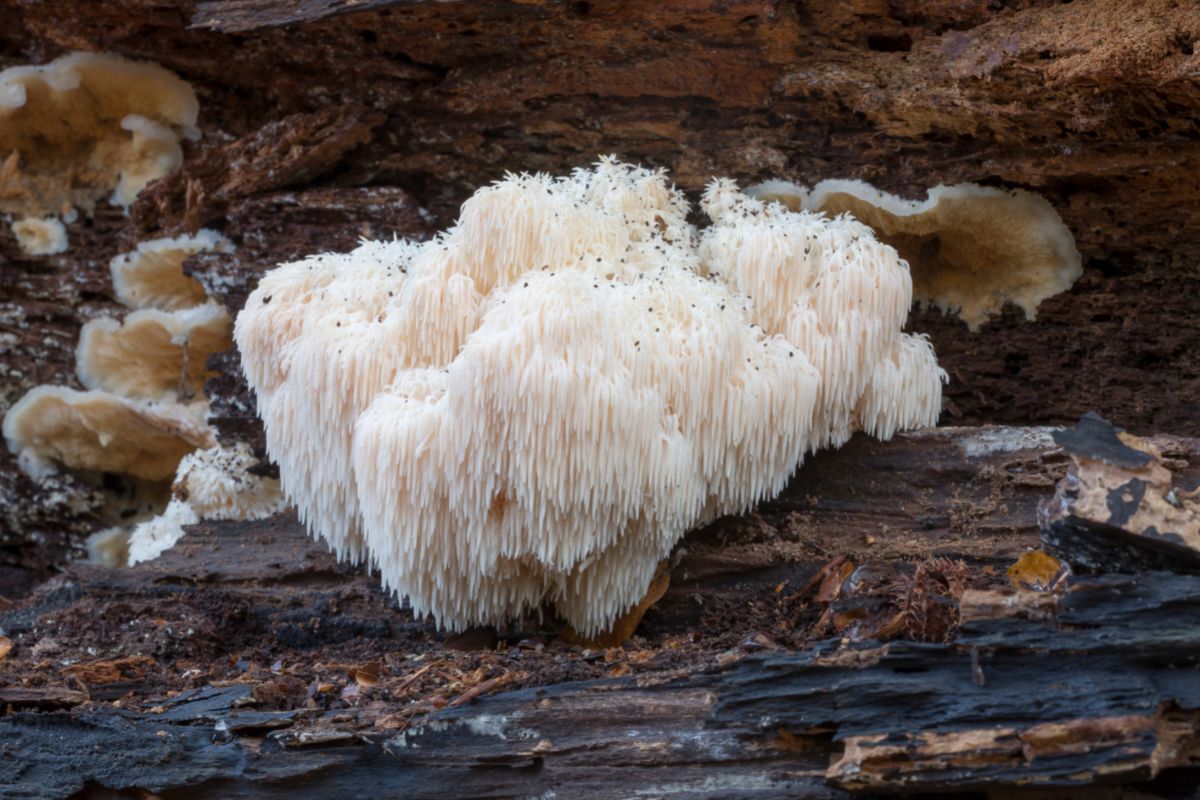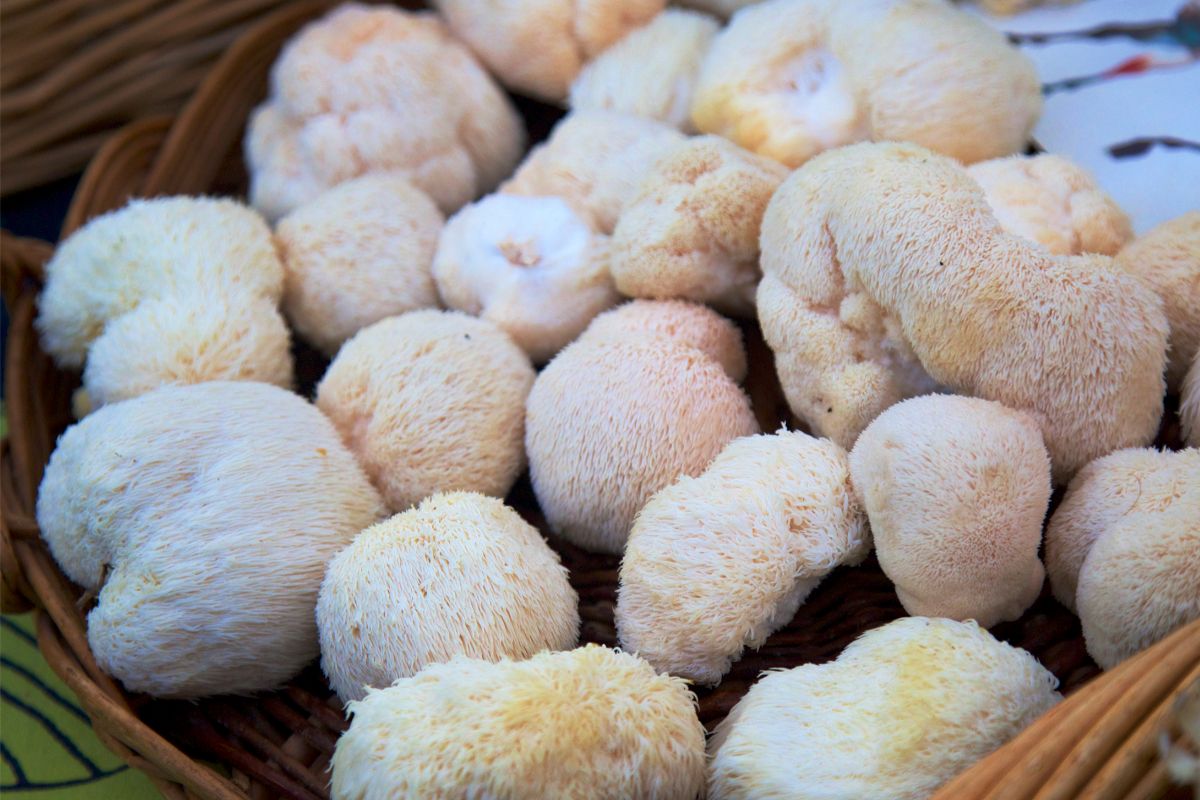What is a Lion’s Mane Mushroom?
The Lion’s Mane mushroom (Hericium Erinaceus) grows on the trunks of dead hardwood trees, such as oak. The Lion’s Mane mushroom pasta recipe applies this mushroom as one of its main ingredients. The East Asians also used this mushroom as medicine for a long time.
The Lion’s Mane mushroom may help with nerve growth and function. Bioactive compounds in Lion’s Mane mushrooms have favorable benefits on the body. What more do you need to know?

Where to Find Lion’s Mane Mushrooms
Lion’s Mane mushrooms (Hieracium species) grow on dead logs in North America and Canada in late summer and fall. It also grows in the wounds of dying or dead trees. You can always see it on hardwood trees.
With their white cascading spines and natural attraction to oak logs, Lion’s Mane is simple to spot. You’ll also notice that they all grow in a clump together.
Certain inedible mushrooms resemble a Lion’s Mane. So, ensure you have the edible mushroom when planning for Lion’s Mane pasta recipe. If you’re doubtful, always consult an expert.
Is it Possible to Create a Lion’s Mane Mushroom Habitat?
You’ll need to start with an agar culture and make your grain spawn to grow Lion’s Mane in a habitat. You groom Lion’s Mane in the same way you groom other species.
To do it, grow the culture on agar to produce grain spawn, then transfer it to a bulk substrate and allow it to fruit. You can also grow Lion’s Mane from liquid culture, but you’ll want to put it on agar for long-term storage and reuse.
After that, mix Lion’s Mane spawn with a substrate. Hardwood sawdust with bran, sometimes known as a fruiting block, works well.
Place the fruiting block in a bag in a humid environment, make a few X-like cuts on the bag’s side, and set it on its side on a plate. To encourage Lion’s Mane to grow, mist inside the bag with a spray bottle a few times a day and make sure plenty of fresh air is circulating. The Lion’s Mane mushroom will start sprouting from the bag’s openings.
More About Lion’s Mane Mushroom Habitat
Hardwoods are the natural habitat of the Lion’s Mane mushroom. Walnut, beech, maple, birch, and black walnut are the most common trees that support the growth of this mushroom.
You’ll commonly see them growing on dead logs during summer or fall in North America and Canada. You can also find this fungus in dead or dying trees’ wounds.
Growing a culture out of agar to form grain spawn, adding it to a fruiting block, and keeping it humid, aired, and watered to help them grow can create a synthetic environment for Lion’s Mane mushrooms.
However, if you’re looking for them in the wild, search for their white spines growing on dead logs throughout North America and Canada.
What do Lion’s Mane Mushrooms Taste Like?
Another reason for adoring the Lion’s Mane mushrooms is that they’re tasty when you cook them, resembling crab or lobster meat in flavor and texture. Many people use them as a substitute for seafood.
Lion’s Mane Mushrooms and Health Benefits
Lion’s Mane mushrooms are famous for their remarkable health benefits. The following are some of the advantages of Lion’s Mane Mushrooms:
Dementia Prevention
The brain’s ability to expand and make new connections reduces with age, which tells why older people’s mental ability is low.
Hericenones and erinacines are two unique chemicals found in Lion’s Mane mushrooms that increase the formation of brain cells.
Animal studies show that Lion’s Mane may help guard against Alzheimer’s disease, a degenerative brain illness that causes progressive memory loss.
In reality, Lion’s Mane mushroom and its extracts diminish memory loss symptoms in rats and keep neurons against amyloid-beta plaques, which form in the brain during Alzheimer’s disease.
While no studies show whether Lion’s Mane mushroom can help those with Alzheimer’s disease, it improves mental performance.
Some of Lion’s Mane mushroom’s good benefits on brain health is its ability to increase neuron growth and help to protect the brain from Alzheimer’s-related damage. However, it’s worth noting that most of the research is on animals or in test tubes. As a result, we require more research on its effects on humans.
Assist the Digestive System
Ulcers can form in the small intestine, stomach, or large intestine, among other places in your digestive system.
Overgrowth of H Pylori bacteria and damage to the mucous membrane of the stomach, which develops by long-term use of nonsteroidal anti-inflammatory medicines (NSAIDs), are two significant causes of stomach ulcers.
By suppressing H Pylori’s growth and protecting the stomach lining from injury, Lion’s Mane extract may protect against the formation of stomach ulcers.
Several studies show that Lion’s Mane extract can stop H Pylori from growing in a test tube, but no research shows if it has the same impact on the stomach.
In addition, an animal study indicated that Lion’s Mane extract was more efficient than typical acid-lowering medications in the prevention of alcohol-induced stomach ulcers – with no harmful side effects.
Lion’s Mane extract reduces inflammation and prevents tissue damage in other parts of the intestines. They may even aid in treating inflammatory bowel illnesses such as ulcerative colitis and Crohn’s disease.
According to some studies, taking a mushroom supplement containing 14 percent Lion’s Mane extract considerably reduces symptoms and improves the quality of life in persons with ulcerative colitis after three weeks.
Overall, evidence suggests that Lion’s Mane extract may help prevent ulcers from developing, but there’s a need for further studies on humans.

Boost Your Immune System
A powerful immune system protects you from bacteria, viruses, and other disease-causing organisms. On the other hand, a weakened immune system puts the body in danger of contracting infectious diseases.
According to animal studies, Lion’s Mane mushroom increases the activity of the intestinal immune system, which protects the body against pathogens that enter the gut through the mouth or nose.
The immune-boosting properties of Lion’s Mane mushrooms are intriguing, but research in this field is still in its early stages.
Lion’s Mane Mushroom Pasta Recipe Substitutions
Many medicinal mushroom collectors enjoy stacking their fungi for maximum immune-boosting, brain-boosting, and antioxidant potential. The combination of lion’s mane and cordyceps is especially powerful since it has nootropic and physically energetic characteristics, allowing you to fire mentally and physically on all cylinders.
While preparing the Lion’s Mane mushroom pasta recipe, you can mix and match various mushroom products, including reishi (the immortal mushroom), turkey tail (ultimate immune protection), Chaga mushroom, shiitake mushroom, maitake mushroom, and many others. Read our article and find out Chanterelle Mushrooms–Recipes For You!
A Lion’s Mane Mushroom Recipe
Time: 30 minutes
Serving size: 2 servings
Prep time: 10 minutes
Cook time: 20 minutes
Nutritional Facts/Info Per Serving/In Total:
- Calories: 750kcal
- Carbohydrates: 2.5 ounces (71grams)
- Protein: 0.63 ounces (18grams)
- Fat: 1.48 ounces (42grams)
- Saturated Fat: 0.39 ounces (11grams)
- Cholesterol: 0.0015 ounces (43mg)
- Sodium: 0.308 ounces (875mg)
- Fiber: 0.105 ounces (3grams)
- Sugar: 0.246 ounces (7grams)
Ingredients
- 1 tablespoon olive oil
- 1 medium Serrano pepper (chopped)
- 10 ounces (283 grams) of cherry tomatoes (sliced in half)
- ½ cup seafood broth (or wine)
- ½ teaspoon garlic powder
- ½ teaspoon sea salt
- ¼ teaspoon onion powder
- ½ cup whipping cream (or Half-and-half)
- ¼ teaspoon cayenne pepper
- 2 tablespoon butter
- ¼ lb (113.5 grams) Lion’s Mane mushrooms
- 2 cups uncooked penne pasta
- 1 ounce (28.35 grams) Asiago cheese
- 2 tablespoons fresh Italian parsley (chopped)
Directions
- In a saucepan, pour the olive oil, cover the pot with the lid and add the sliced tomatoes, and cook for 5 minutes on low heat.
- Prepare the pasta using the package instructions.
- Toss in a Serrano pepper and cook for a minute with the tomatoes. Season the tomatoes with salt, garlic powder, onion powder, and cayenne pepper before pouring the broth over them. Cover and cook the sauce for another 5 minutes on low heat.
- Using an immersion blender, pour cream into the pot and blend until smooth (or somewhat lumpy).
- Tear the Lion’s Mane mushroom into little pieces using your hands. In a separate skillet, melt butter and sauté for a few minutes. In another bowl, combine the sautéed mushrooms and the sauce.
- Drain the pasta and stir it into the sauce to incorporate everything. Using a plate, serve the Lion’s Mane crispy mushroom pasta and top with shaved Asiago cheese and minced Italian parsley.
Lion’s Mane Mushroom Recipe Tips
The following tips are essential when you prepare yourself for a Lion’s Mane mushroom pasta recipe:
- A food processor or a Ninja blender will suffice if you have no immersion blender. When blending the sauce, make sure it’s not too hot, or the sauce will splatter when you detach the blade from the cup.
- Remove the Serrano and cayenne pepper for a milder meal. Slice another Serrano pepper and put it on the spaghetti plate before serving for an extra fiery entrée.
- You can use Parmesan cheese instead of Asiago cheese to top the pasta.
- Look for Lion’s Mane Mushrooms high up on tree trunks and branches while foraging.
Storing Lion’s Mane Mushrooms
To stay healthy and tasty, Lion’s Mane mushrooms require air circulation. It’s also true that cooler temperatures keep the fresh mushrooms in better condition than when you keep them in heat or expose them to direct sunlight.
A fridge is the best place to keep your Lion’s Mane mushroom, but you shouldn’t just throw them in without any protection. They can release spores on your other meals, and the direct contact with air can cause them to dry up or spoil.
Put them in a brown paper bag with the top folded down to protect them while allowing some air movement. You don’t want to put them in a fridge drawer because they won’t have enough air circulation. But, always give them a quick wash before cooking whenever you’re ready to consume them.
Since these mushrooms grow on wood, there may be some dirt or debris that you don’t want to eat. However, never immerse them in water or leave them under running water for longer. They’ll get soggy and be unsuitable for cooking.

Mushroom’s the Word!
Because this mushroom is adaptable to practically any meal, you may use a Lion’s Mane mushroom pasta recipe to delight any palate.
Do you want your Lion’s Mane to be a side dish? No problem! Cut them up into bite-size pieces and season or marinate them as you usually do for a delicious addition to your dishes.
The Lion’s Mane mushroom also tastes fantastic in a sandwich, so you can use it in place of other varieties of mushrooms in a sandwich.
Because the mushroom has a meaty flavor and texture, you can even use it as a meat substitute in any recipe.

Community of passionate writers and content creators who share a love for Italian heritage, culture, travel, food, and the Italian-American community. Our mission is to celebrate Italy’s rich history and traditions and connect with others who share the same passion.

